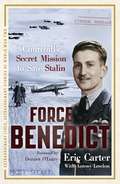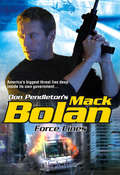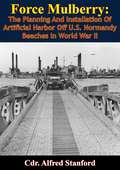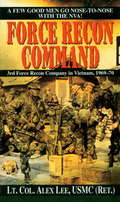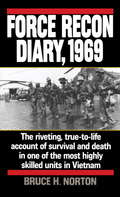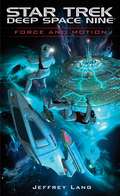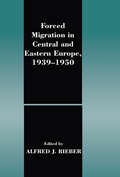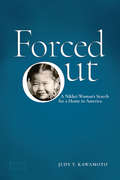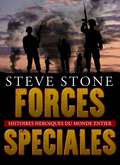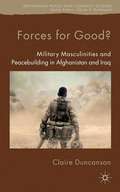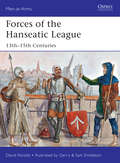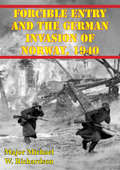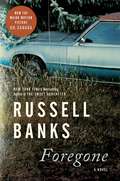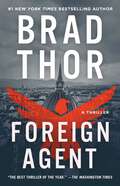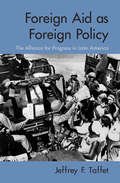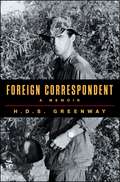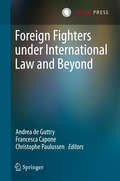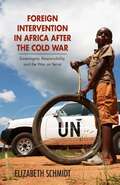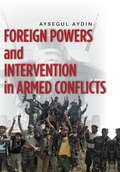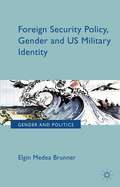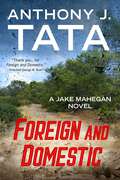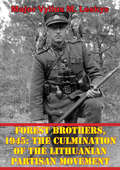- Table View
- List View
Force Benedict (Extraordinary Lives, Extraordinary Stories of World War Two #2)
by Eric Carter Anthony LovelessSecond World War fighter pilot Eric Carter is one of only four surviving members of a secret mission, code-named 'Force Benedict'. Sanctioned by Winston Churchill in 1941 Force Benedict was dispatched to defend Murmansk, the USSR's only port not under Nazi occupation. If Murmansk fell, Soviet resistance against the Nazis would be hard to sustain and Hitler would be able to turn all his forces on Britain...Force Benedict was under the command of New Zealand-born RAF Wing Commander Henry Neville Gynes Ramsbottom-Isherwood, who led two squadrons of Hurricane fighters, pilots and ground crew which were shipped to Russia in total secrecy on the first ever Arctic Convoy. They were told to defend Murmansk against the Germans 'at all costs'. 'We all reckoned the government thought we'd never survive' - but Eric Carter did, and was threatened with Court Martial if he talked about where he'd been or what he'd done. Now he reveals his experiences of seventy years ago in the hell on earth that was Murmansk, the largest city north of the Arctic Circle. It will also include previously unseen photos and documents, as well as exploring - for the first time - other intriguing aspects of Force Benedict.
Force Lines (SuperBolan #112)
by Don PendletonBLACK HORIZON. The most dangerous enemies are the unseen, and Mack Bolan's instincts are kicking in, alerting him to a horrific conspiracy so deep within the U.S. government that invisible spooks with unlimited power will never be held accountable for the atrocities they unleash. One conspiracy wrapped in another: an Armageddon group called Sons of Revelation, a man-made plague set to be released in south Florida, and rumors of terror imports from the home team. It's treason, betrayal of the highest order, an act of savagery that will not go unchallenged-at whatever price Bolan may have to pay. Judgment Day is now, for patriots willing to sell out their nation for greed and twisted ambition.
Force Mulberry: The Planning And Installation Of Artificial Harbor Off U.S. Normandy Beaches In World War II [Illustrated Edition]
by Cdr. Alfred Stanford Rear Admiral Samuel E. MorisonThis edition contains numerous illustrations and maps."In this book Commander Stanford has made a very important contribution to the history of World War II, and in the writing of it he has recaptured the tense excitement, almost desperation, of planning and executing the landings in Normandy. The "Mulberries," the two artificial harbors established immediately after the initial landings, were absolutely essential for the success of Operation Overlord. For, as we found out in World War II, the most difficult thing in an amphibious operation is not to establish the initial beachhead--that can almost always be done if sufficient force is employed and tactical surprise is obtained--but to sustain and reinforce the ground troops against the beachhead, and attain the objective."Massive as was the Anglo-American assault on the Normandy beaches, it had to be followed up immediately by even greater increments of men, armor, vehicles and supplies to make it succeed. There was no possibility of getting all this ashore over wave-lashed beaches where spring tides rose twenty-one feet. One or more ports were essential to maintain an even flow of men and matériel. But all the French ports, notably the nearest ones at Cherbourg and Le Havre, were so strongly held by the enemy that the capture of one would employ forces badly needed elsewhere for at least six weeks, during which the Germans would be unexpectedly weak or very stupid if they did not succeed in rubbing out the initial beachhead."The only possible way out of this dilemma was the apparently impossible task of providing sheltered water off the beaches within a matter of three days. Since speed was of the essence, all elements of the artificial harbors would have to be constructed in England, towed across the Channel under danger of wind, weather and enemy air attack, and sited under fire..."--Rear Admiral Samuel E. Morison
Force Recon Command
by Alex LeeTHE A SHAU VALLEYWHERE THE NVA WAS KING . . . In order to prevent surprise attacks on U.S. forces as they were pulling out of Vietnam, someone had to be able to pinpoint the NVA's movements. That dangerous job was the assignment of then-major Alex Lee and the Marines of the 3rd Force Reconnaissance Company when he assumed command in late 1969. They became the tip of the spear for Lt. Gen. Herman Nickerson's III MAF. And each time one of Lee's small, well-motivated, well-led, and wildly outnumbered teams was airlifted into the field, the men never knew if the day would end violently.But whether tracking NVA movements, recovering downed air crews, or making bomb-damage assessments after B-52 strikes, Major Lee's Few Good Men never forgot who they were: Each of them was in Vietnam to live like a Marine, win like a Marine, and, if need be, die like a Marine.Forthright and unabashed, Lieutenant Colonel Lee leaves no controversy untouched and no awe-inspiring tale untold in this gripping account of 3rd Force Recon's self-sacrifice and heroic achievement in the face of overwhelming odds.From the Paperback edition.
Force Recon Diary, 1969
by Major Bruce H. NortonThe riveting, true-to-life account of survival, heroism and death in the elite Marine 3d Force Recon unit, one of one two Marine units to receive the Valorous Unit Citation during the Vietnam War. Doc Norton, leader of 3d Force Recon, recounts his team's experiences behind enemy lines during the tense patrols, sudden ambushes and acts of supreme sacrifice that occurred as they gathered valuable information about NVA operations right from the source.
Force and Motion (Star Trek)
by Jeffrey LangA thrilling original novel set in the universe of Star Trek: The Next Generation / Deep Space Nine!In 2367, Captain Benjamin Maxwell of the starship Phoenix ordered the destruction of a Cardassian warship and a supply vessel, killing more than six hundred crew members. Maxwell believed that the Cardassians were arming for a new attack on the Federation, and though history eventually proved he was probably correct, the Federation had no choice but to court martial and incarcerate him. Almost twenty years have passed, and now Maxwell is a free man, working as a maintenance engineer on the private science station Robert Hooke, home to crackpots, fringe researchers, and, possibly, something much darker and deadlier. Maxwell's former crewmate, Chief Miles O'Brien, and O'Brien's colleague, Lieutenant Commander Nog, have come for a visit. Unfortunately, history has proven that whenever O'Brien and Nog leave Deep Space 9 together, unpredictable forces are set into motion... TM, ®, & © 2016 CBS Studios, Inc. STAR TREK and related marks are trademarks of CBS Studios, Inc. All Rights Reserved.
Forced Migration in Central and Eastern Europe, 1939-1950
by Alfred J. RieberThese nine case studies, written by Russian, German and Austrian scholars and based on archival findings, should shed new light on deportations and resettlement in Poland, Hungary, Czechoslovakia and Germany. The introduction places forced migration throughout the region in a historical context.
Forced Out: A Nikkei Woman’s Search for a Home in America (Nikkei in the Americas)
by Judy Y. KawamotoForced Out: A Nikkei Woman’s Search for a Home in America offers insight into “voluntary evacuation,” a little-known Japanese American experience during World War II, and the lasting effects of cultural trauma. Of the roughly 120,000 people forced from their homes by Executive Order 9066, around 5,000 were able to escape incarceration beforehand by fleeing inland. In a series of beautifully written essays, Judy Kawamoto recounts her family’s flight from their home in Washington to Wyoming, their later moves to Montana and Colorado, and the influence of those experiences on the rest of her life. Hers is a story shared by the many families who lost everything and had to start over in often suspicious and hostile environments. Kawamoto vividly illustrates the details of her family’s daily life, the discrimination and financial hardship they experienced, and the isolation that came from experiencing the horrors of the 1940s very differently than many other Japanese Americans. Chapters address her personal and often unconscious reactions to her parents’ trauma, as well as her own subsequent travels around much of the world, exploring, learning, enjoying, but also unconsciously acting out a continual search for a home. Showing how the impacts of traumatic events are collective and generational, Kawamoto draws interconnections between her family’s displacement and later aspects of her life and juxtaposes the impact of her early experiences and questions of identity, culture, and assimilation. Forced Out will be of great interest to the general reader as well as students and scholars of ethnic studies, Asian American studies, history, education, and mental health.
Forced to Change: Crisis and Reform in the Canadian Armed Forces
by Colonel Bernd Horn Dr Bill Bentley Lieutenant-General Ret DallaireUndeniably, the 1990s were a period of crisis for the Canadian Armed Forces (CAF). Drastic budget reductions and a series of endless scandals all collided to form the perfect storm. The outcome of this was nothing short of the implosion of the Canadian Armed Forces Officer Corps. Stripped by the government of the right to regulate itself, the Officer Corps, which represented the nation’s stewards of the profession of arms, was forced to reform itself. Key to this transformation was education. However, the road was not easy, as cultural change rarely is. Forced to Change tells the story of how the Canadian Armed Forces found itself at its lowest point in history and how it managed to reform itself. The question is whether it was a fundamental transformation or just a temporary adjustment to weather the storm.
Forces Speciales : Histories Heroiques Du Monde Entier
by Steve StoneLes forces spéciales sont des unités militaires formées pour accomplir des missions non conventionnelles. Elles sont apparues au début du XXe siècle et ont connu un essor important au cours de la Seconde Guerre mondiale, avec la création de forces spéciales telles que les SAS et les U.S. Navy SEALs. Cette sélection d'histoires captivantes sur les forces spéciales du monde entier. Couvrant quatre décennies d'opérations extraordinaires, cette sélection de récits captivants des forces spéciales du monde entier. On y trouve notamment les opérations Eagle Claw, Gothic Serpent et Neptune Spear, ainsi que de nombreuses autres histoires pleines d'action. Les forces spéciales sont très respectées et les soldats qui font partie de ces unités d'élite ont subi une sélection et un entraînement difficiles pour arriver en première ligne. Qu'il s'agisse d'un opérateur de la Delta Force, d'un Navy SEAL, d'un soldat du SAS ou de tout autre opérateur des forces spéciales. Aujourd'hui, une étroite collaboration est la clé de nombreuses missions, même si la rivalité existe pour être le meilleur, le premier à atteindre un objectif ou à s'attaquer à une cible de premier plan. Les histoires de ce livre ont été choisies pour montrer non seulement les succès, mais aussi les échecs et les leçons tirées de chaque opération. La haute technologie ne remplace toujours pas les bottes sur le terrain, où des agents hautement qualifiés peuvent encore recueillir des renseignements qu'aucun œil dans le ciel n'est capable d'obtenir.
Forces for Good?
by Claire DuncansonThis book utilises the growing phenomenon of British soldier narratives from Iraq and Afghanistan to explore how British soldiers make sense of their role on these complex, multi-dimensional operations. It aims to intervene in the debates within critical feminist scholarship over whether soldiers can ever be agents of peace.
Forces of the Hanseatic League
by David Nicolle Gerry EmbletonThe famous but largely unchronicled Hanseatic League (or simple "the Hanse/Hansa") was a Tuetonic German commercial and defensive federation of merchant guilds based in harbor towns along the North Sea and Baltic coasts of what are now Germany and her neighbors, which eventually dominated maritime trade in Northern Europe and spread its influence much further afield. The League was formed to protect the economic and political interests of member cities throughout a vast and complex trading network. While most members remained basically subject to the local rulers who profited from their prosperity, in a sense the League might be seen as foreshadowing today's ambiguous relationship between global corporations and political nation states.The League continued to operate well into the 17th century, but its golden age was between c. 1200 and c. 1500; thereafter it failed to take full advantage of the wave of maritime exploration to the west, south and east of Europe. During its 300 years of dominance the League's large ships - called "cogs" - were at the forefront of maritime technology, were early users of cannon, and were manned by strong fighting crews to defend them from pirates in both open-sea and river warfare. The home cities raised their own armies for mutual defence, and their riches both allowed them, and required them, to invest in fortifications and gunpowder weapons, since as very attractive targets they were subjected to sieges at various times.
Forcible Entry And The German Invasion Of Norway, 1940
by Major Michael W. RichardsonThe air-sea-land forcible entry of Norway in 1940 utilized German operational innovation and boldness to secure victory. The Germans clearly met, and understood, the conditions that were necessary to achieve victory. The central research question of this thesis is: What lessons concerning setting the conditions for present day forcible entry operations can be gleaned from the successful German invasion of Norway in 1940? Forcible entry is the introduction of an aggregation of military personnel, weapons systems, vehicles, and necessary support, or a combination thereof, embarked for the purpose of gaining access through land, air, or amphibious operations into an objective area against resistance. This aggregation of military force attempts to set conditions that cripple the enemy's ability to react decisively to, or interfere with, the forcible entry operation. The German emphasis on surprise and speed, an effective psychological campaign, and combined operations under a unified command in the invasion of Norway rendered the Norwegian and Allied intervention forces (including the Royal Navy which dominated the seas in the area) incapable of seriously interfering with the German forcible entry.
Foregone: A Novel
by Russell BanksThe inspiration for the Major Motion Picture O, Canada directed by Paul Schrader and starring Richard Gere, Uma Thurman, Jacob Elordi, and Michael Imperioli.A searing novel about memory, abandonment, and betrayal from the acclaimed and bestselling Russell Banks "During a career stretching almost half a century, Russell Banks has published an extraordinary collection of brave, morally imperative novels. . . . In this complex and powerful novel, we come face to face with the excruciating allure of redemption." —Washington PostAt the center of Foregone is famed Canadian American leftist documentary filmmaker Leonard Fife, one of sixty thousand draft evaders and deserters who fled to Canada to avoid serving in Vietnam. Fife, now in his late seventies, is dying of cancer in Montreal and has agreed to a final interview in which he is determined to bare all his secrets at last, to demythologize his mythologized life. The interview is filmed by his acolyte and ex–star student, Malcolm MacLeod, in the presence of Fife’s wife and alongside Malcolm’s producer, cinematographer, and sound technician, all of whom have long admired Fife but who must now absorb the meaning of his astonishing, dark confession.Imaginatively structured around Fife’s secret memories and alternating between the experiences of the characters who are filming his confession, the novel challenges our assumptions and understanding about a significant lost chapter in American history and the nature of memory itself. Russell Banks gives us a daring and resonant work about the scope of one man’s mysterious life, revealed through the fragments of his recovered past.
Foreign Agent: A Thriller (The Scot Harvath Series #15)
by Brad Thor&“The best thriller of the year...an exciting and entertaining read.&” —The Washington Times &“A top-notch thriller.&” —Bill O&’Reilly From #1 New York Times and #1 Wall Street Journal bestselling author Brad Thor—a brilliant thriller as &“current as tomorrow&’s headlines&” (Dan Brown, #1 New York Times bestselling author). Terrorism in Europe has spun out of control. The United States has decided on a dramatic response. Now, the CIA needs a very special kind of operative.Scot Harvath has exactly the skills the CIA is looking for. He&’s a former U.S. Navy SEAL with extensive experience in espionage. Working for a private intelligence company, he will provide the CIA, and more important, the President, with absolute deniability. But deep within the Russian Caucasus, Moscow also has its own special kind of operative. As a child, Sacha Baseyev endured an unimaginable horror. Today, he lives and breathes for only one reason—to kill. And he will kill as many Americans as it takes to accomplish his mission. When a clandestine American operations team is ambushed near Syria, all signs point toward a dangerous informant in Brussels. But as Harvath searches for the man, he uncovers another actor—a rogue player hell-bent on forcing America&’s hand and drawing it into a confrontation deadlier than anyone could have imagined. As the attacks mount, and terror is brought to the very doorstep of the White House, Harvath finds himself in the race of his life. From Vienna, Brussels, and Berlin, to Malta, Jordan, and Syria—he will push himself beyond the edge in order to confront one of the greatest evils the world has ever known.
Foreign Aid as Foreign Policy: The Alliance for Progress in Latin America
by Jeffrey TaffetForeign Aid as Foreign Policy presents a wide-ranging, thoughtful analysis of the most significant economic-aid program of the 1960s, John F. Kennedy’s Alliance for Progress. Introduced in 1961, the program was a ten-year, multi-billion-dollar foreign-aid commitment to Latin American nations, meant to help promote economic growth and political reform, with the long-term goal of countering Communism in the region. Considering the Alliance for Progress in Chile, Brazil, the Dominican Republic, and Colombia, Jeffrey F. Taffet deftly examines the program’s successes and failures, providing an in-depth discussion of economic aid and foreign policy, showing how policies set in the 1960s are still affecting how the U.S. conducts foreign policy today. This study adds an important chapter to the history of US-Latin American Relations.
Foreign Correspondent
by H.D.S. GreenwayDavid Greenway, a journalist's journalist in the tradition of Michael Herr, David Halberstam, and Dexter Filkins. In this vivid memoir, he tells us what it's like to report a war up close.Reporter David Greenway was at the White House the day Kennedy was assassinated. He was in the jungles of Vietnam in that war's most dangerous days, and left Saigon by helicopter from the American embassy as the city was falling. He was with Sean Flynn when Flynn decided to get an entire New Guinea village high on hash, and with him hours before he disappeared in Cambodia. He escorted John le Carre around South East Asia as he researched The Honourable Schoolboy. He was wounded in Vietnam and awarded a Bronze Star for rescuing a Marine. He was with Sidney Schanberg and Dith Pran in Phnom Penh before the city descended into the killing fields of the Khmer Rouge. Greenway covered Sadat in Jerusalem, civil war and bombing in Lebanon, ethnic cleansing and genocide the Balkans, the Gulf Wars (both), and reported from Afghanistan and Iraq as they collapsed into civil war. This is a great adventure story--the life of a war correspondent on the front lines for five decades, eye-witness to come of the most violent and heroic scenes in recent history.
Foreign Fighters under International Law and Beyond
by Christophe Paulussen Andrea De Guttry Francesca CaponeThis book offers various perspectives, with an international legal focus, on an important and underexplored topic, which has recently gained momentum: the issue of foreign fighters. It provides an overview of challenges, pays considerable attention to the status of foreign fighters, and addresses numerous approaches, both at the supranational and national level, on how to tackle this problem. Outstanding experts in the field - lawyers, historians and political scientists - contributed to the present volume, providing the reader with a multitude of views concerning this multifaceted phenomenon. Particular attention is paid to its implications in light of the armed conflicts currently taking place in Syria and Iraq. Andrea de Guttry is a Full Professor of International Law at the Scuola Superiore Sant'Anna, Pisa, Italy. Francesca Capone is a Research Fellow in Public International Law at the Scuola Superiore Sant'Anna. Christophe Paulussen is a Senior Researcher at the T. M. C. Asser Instituut in The Hague, the Netherlands, and a Research Fellow at the International Centre for Counter-Terrorism - The Hague.
Foreign Intervention In Africa After The Cold War: Sovereignty, Responsibility, And The War On Terror (Research In International Studies, Global And Comparative Studies)
by Elizabeth SchmidtIn Foreign Intervention in Africa after the Cold War--interdisciplinary in approach and intended for nonspecialists--Elizabeth Schmidt provides a new framework for thinking about foreign political and military intervention in Africa, its purposes, and its consequences. She focuses on the quarter century following the Cold War (1991-2017), when neighboring states and subregional, regional, and global organizations and networks joined extracontinental powers in support of diverse forces in the war-making and peace-building processes. During this period, two rationales were used to justify intervention: a response to instability, with the corollary of responsibility to protect, and the war on terror. <p><p> Often overlooked in discussions of poverty and violence in Africa is the fact that many of the challenges facing the continent today are rooted in colonial political and economic practices, in Cold War alliances, and in attempts by outsiders to influence African political and economic systems during the decolonization and postindependence periods. Although conflicts in Africa emerged from local issues, external political and military interventions altered their dynamics and rendered them more lethal. Foreign Intervention in Africa after the Cold War counters oversimplification and distortions and offers a new continentwide perspective, illuminated by trenchant case studies.
Foreign Planes in the Service of the Luftwaffe
by Jean-Louis RobaThis pictorial history shows the full extent of captured foreign aircraft used by Nazi Germany during WWII. No air force in the Second World War would make more use of captured planes than the Luftwaffe. With this in mind, military historian Jean-Louis Roba has tracked down hundreds of such aircraft with rare images that illustrate their uses, careers, and eventual fates. Foreign Planes in the Service of the Luftwaffe covers the complete history of this practice from its inception in the prewar years to the end of the Second World War. Roba&’s significant research on the topic debunks myths about how prepared for war the Germans were in 1939. This volume demonstrates how important captured planes—a decidedly unreliable resource—would become to the Luftwaffe. Translated into English for the first time, Roba&’s investigative work is supported by more than a hundred pictures of the planes themselves, and gives a rare opportunity to see British and American planes repainted in German colors and symbols.
Foreign Powers and Intervention in Armed Conflicts
by Aysegul AydinIntervention in armed conflicts is full of riddles that await attention from scholars and policymakers. This book argues that rethinking intervention-redefining what it is and why foreign powers take an interest in others' conflicts-is of critical importance to understanding how conflicts evolve over time with the entry and exit of external actors. It does this by building a new model of intervention that crosses the traditional boundaries between economics, international relations theory, and security studies, and places the economic interests and domestic political institutions of external states at the center of intervention decisions. Combining quantitative and qualitative evidence from both historical and contemporary conflicts, including interventions in both interstate conflicts and civil wars, it presents an in-depth discussion of a range of interventions-diplomatic, economic, and military-in a variety of international contexts, creating a comprehensive model for future research on the topic.
Foreign Security Policy, Gender, and US Military Identity
by Elgin Medea BrunnerThe concept of 'othering' which can be understood as the process of differentiation from the Self has been a basic tenet of the war story since war stories were first told. This practise of deliberate differentiation is indicative of the fact that war stories are essentially about the production of identity. The aim of this book, therefore, is to unravel some of the gendered ideologies that underpin the link between state identity and foreign security policy by looking at a certain case, state and foreign security policy. In particular this volume explores the identity of the United States through military documents on perception management in conflict from 1991-2007 shedding light on the 'othering' and the 'selfing' that occurs in these particular war stories. In doing so it lays bare the gendered ideologies that underpins US identity between these years as well as exploring potential spaces for alternatives. Thus, this book ventures a detailed and unique look at a particular aspect of the gendered reproduction of the state.
Foreign and Domestic (A Jake Mahegan Thriller #1)
by Anthony J. Tata&“ABSOLUTELY FANTASTIC…PULSE-POUNDING.&” —Brad Thor #1 New York Times bestselling author One year ago, Captain Jake Mahegan led a Delta Force team into Afghanistan to capture an American traitor working for the Taliban. The mission ended in tragedy. The team was infiltrated and decimated by a bomb. An enemy prisoner was killed. Mahegan was dismissed from service—dishonored forever. Now, haunted by the incident, Mahegan is determined to clear his name. The military wants him to stand down. But when the American Taliban returns to domestic soil—headed by the traitor who ruined his life—Mahegan is the only man who knows how to stop him. Outside the law. Under the radar. Out for vengeance… &“I thoroughly enjoyed it…well done! Thank you…for Foreign and Domestic.&” --President George Bush &“Thrilling read!&”--Former Texas Governor Rick PerryBrigadier General Tata donates a portion of his earnings to the USO Metro DC, the North Carolina Heroes Fund, and the Michael Murphy Foundation.
Forensic Seismology and Nuclear Test Bans
by Alan DouglasWith the signing in 1996 of the Comprehensive Nuclear Test Ban Treaty, interest has grown in forensic seismology: the application of seismology to nuclear test ban verification. This book, based on over 50 years of experience in forensic seismology research, charts the development of methods of seismic data analysis. Topics covered include: the estimation of seismic magnitudes, travel-time tables and epicentres; seismic signal processing; and the use of seismometer arrays. Fully illustrated with seismograms from explosions and earthquakes, the book demonstrates methods and problems of visual analysis. Each chapter provides exercises to help the reader familiarise themselves with practical issues in the field of forensic seismology, and figures and solutions to exercises are also available online. The book is a key reference work for academic researchers and specialists in the area of forensic seismology and Earth structure, and will also be valuable to postgraduates in seismology and solid earth geophysics.
Forest Brothers, 1945: The Culmination Of The Lithuanian Partisan Movement
by Major Vylius M. LeskysAlthough the resistance effort maintained its strength ideologically, the Lithuanian partisan movement never recovered from the culminating point in 1945 because of a shortfall in resources, a lack of external support, and the inability of resistance leadership to adapt rapidly enough against a comprehensive Soviet assimilation campaign.While many authors argue that the high point in the Lithuanian partisan war occurred between 1946 and 1947, the totality of evidence points towards a culmination in 1945 from which the effort never recovered. This culminating point may be attributed to a miscalculation of partisan resources on the part of their leadership as well as a lack of external support. The main reason for achieving culmination, however, rested in the inability of partisans to fight a conventional war against a massive, combined arms Soviet force. Mass deportations between three separate occupations and a wave of 60,000 escapees created a vacuum of political, military and moral leadership. Compounded with the realization that there would be no external support from the democratic West, the will of the Lithuanians was bent by the Soviet campaign. Ultimately, the numbers of partisans killed, captured or given amnesty by Soviet forces reflect an apex in military capability in 1945 that drastically diminished thereafter.The pinnacle of partisan effort in 1945 clearly represents a culminating point that forced the Lithuanian resistance movement to shift their operations drastically. Ultimately, based on the totality of evidence, the 1945 culminating point splits the resistance into two stages: 1) 1944-1945-conventional war operations, a period of traditional offensive warfare by an organized partisan movement; and 2) 1946-1953-irregular warfare operations, a period of unremitting decline by a significantly diminished resistance, relegated to a more defensive posture and small scale offensive operations.
